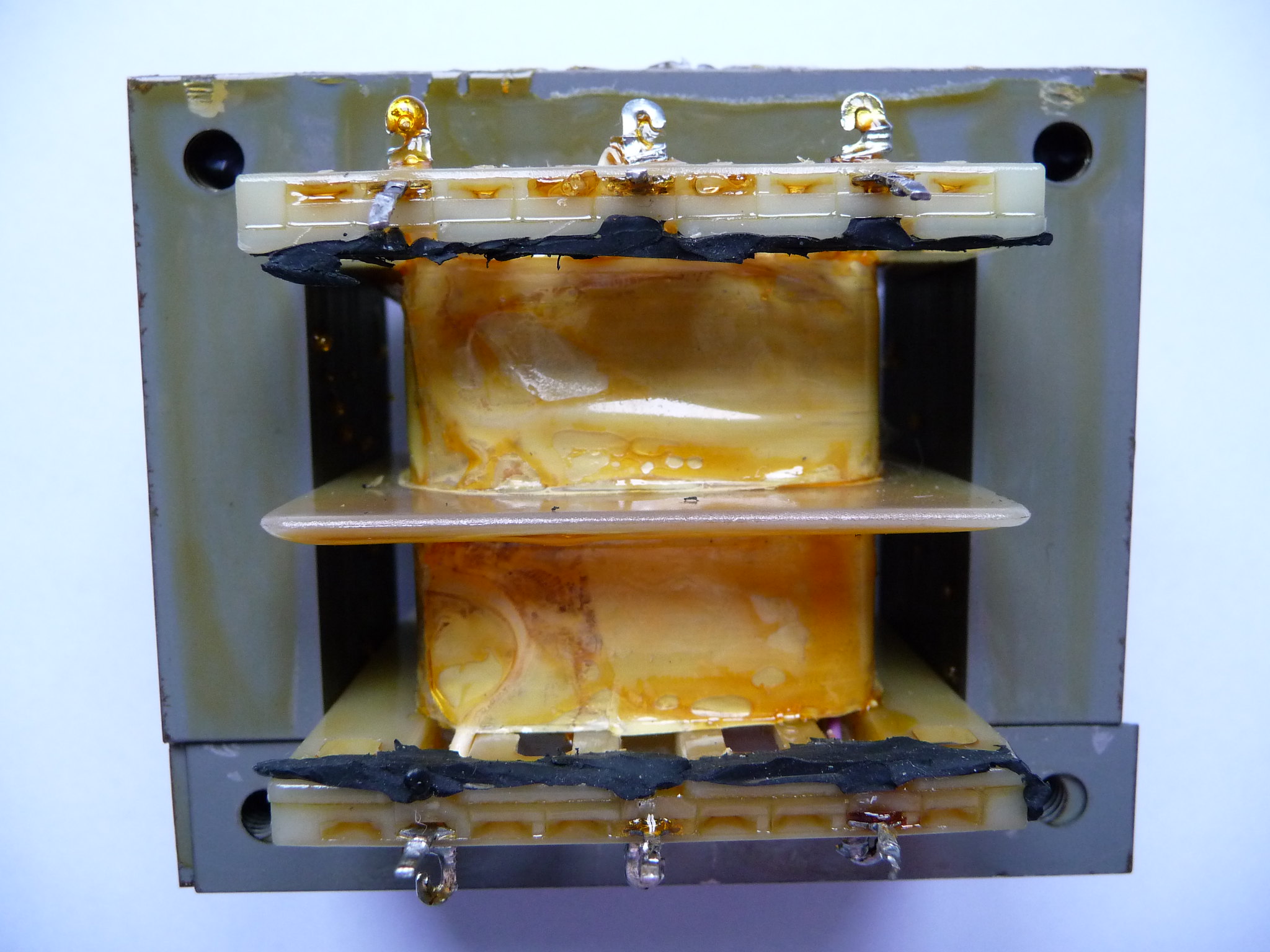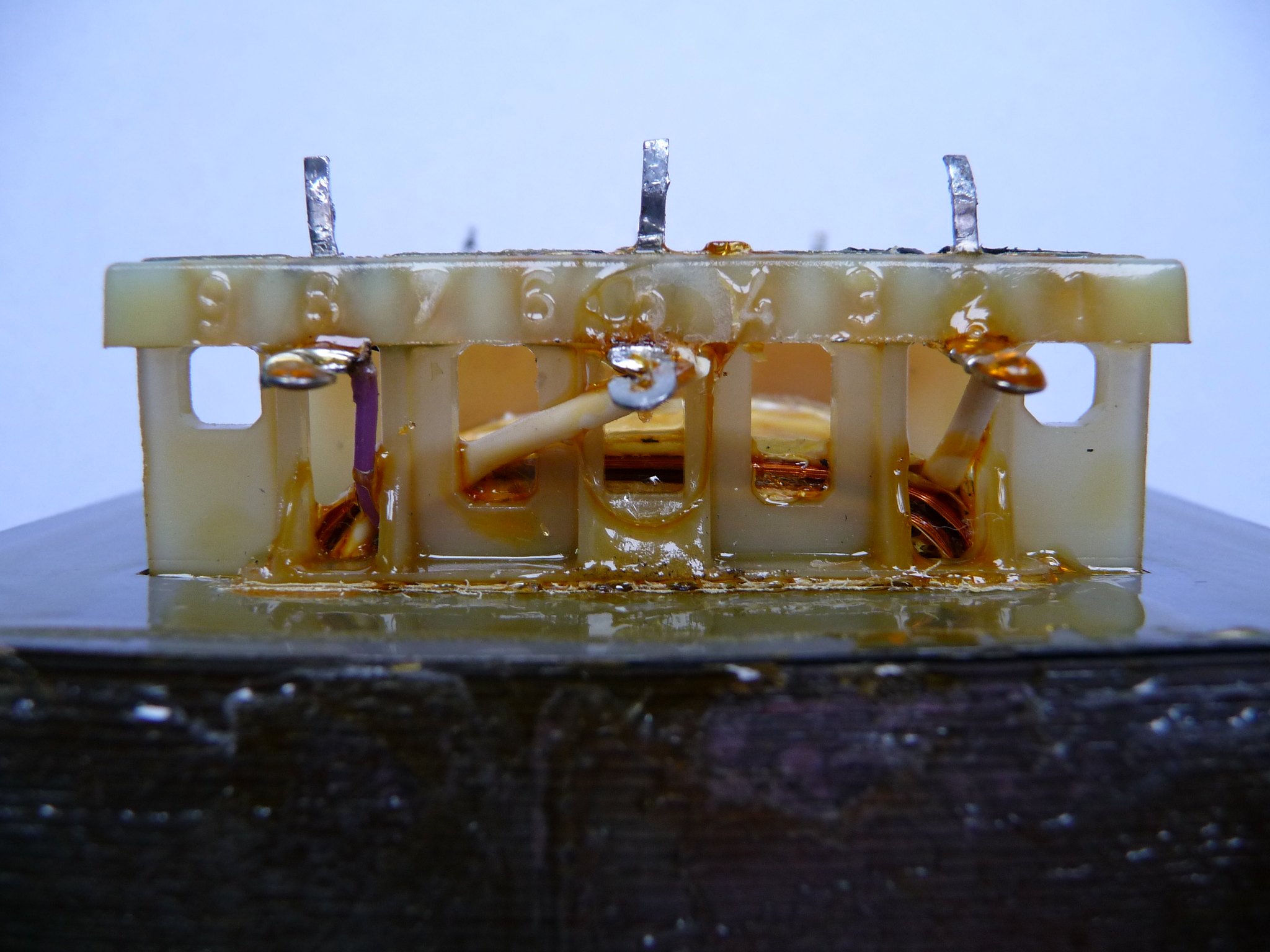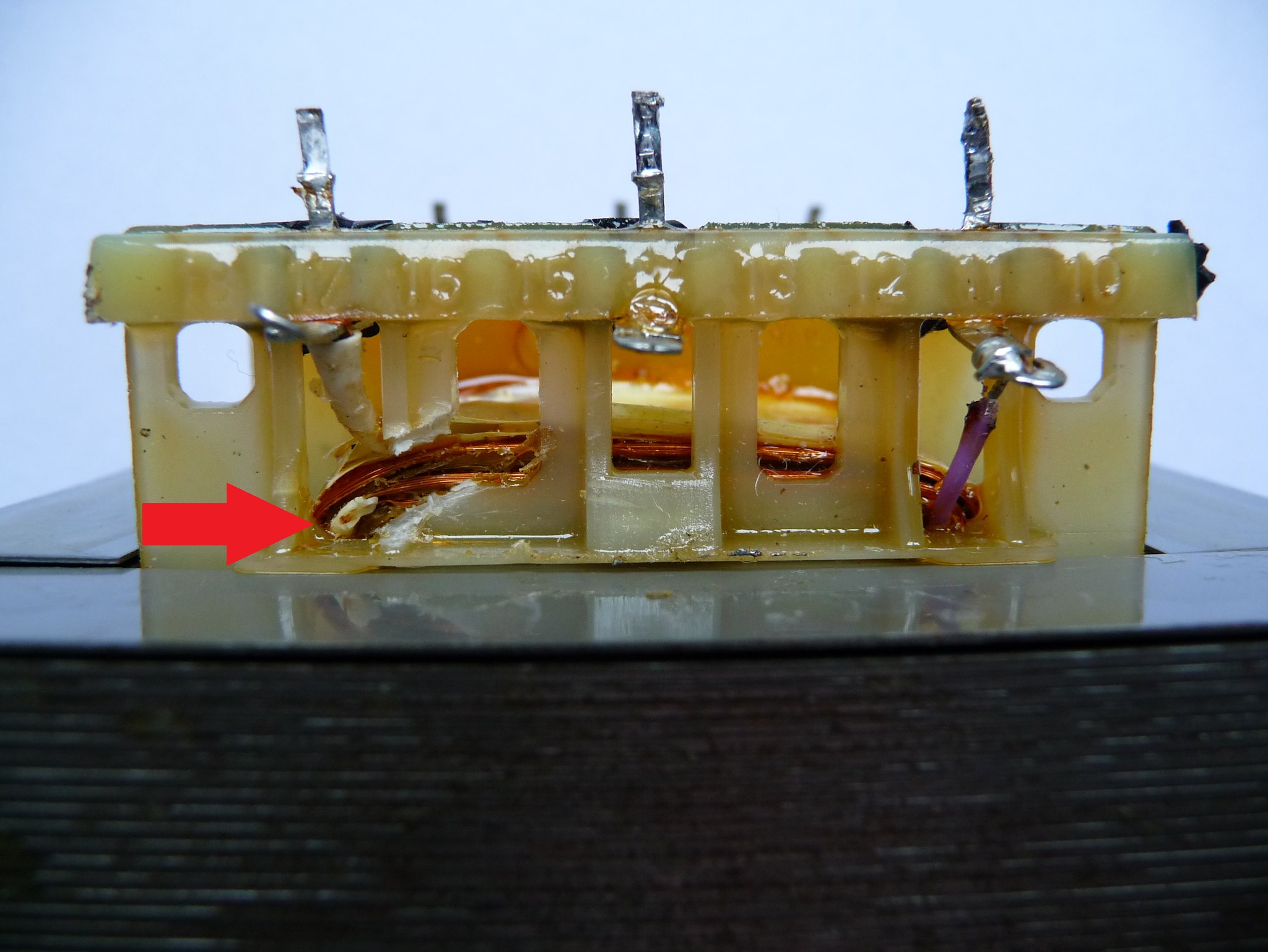Post by solderdude on Oct 17, 2015 6:29:32 GMT
There was a reason I aimed for 1V input voltage...
This way it is very easy to determine the winding ratio.
1V in 130V out (over the outer windings) = 1:130
so 1:65 for each secondary winding.
Your amp provides 200W into 8 Ohm.
You can calculate the voltage that goes with it: sqrt(200 Wx8 Ohm) = 40V !!!!
This means the voltage rails of your amplifier are around +/-65V.
Here come the problems I see...
problem#1:
We are using the transformer the other way around (like the traffo's for the bias)
When you put 40V on a 6V winding you will be saturating the core.
In fact above say 10V you are saturating the core of the trafo which means input power will be converted into heat and thus (part) of the input power will be 'lost'. The output signal will 'compress' at higher listening levels.
problem #2:
Suppose at one point in time accidentally the volume is turned all the way up.
You get 40V AC on your 6V input.
This will give 1500V on the secondary winding (but due to compression will be around 1300V more likely).
This equates to around 3600V peak-peak which is enough to create sparks here and there possibly shorting out the trafo (doesn't have to be)
Since you must be using 4 trafos the secondary voltage will be twice that so 7.2kV between stator one and the membrane.
That by itself also has a bias of 2.5kV.
So between the stator and membrane there could be 10kV.
sparks start to fly at 1mm/kV so the membrane must be 1cm away from the stator unless the stator is (well) isolated.
Chances are a spark may occur and burn a hole in the membrane.
Quad used to have a 'solution' for that and as soon as the input voltage reached a certain level they would short the speaker amp !
This is one of the reasons I used 18V transformers.
40V on an 18V transformer only gives around 400V AC (1200 Vpp) per winding.
Using 8 allowed me to create 3.2kV.
My DIY stators consist of electrical wire so no chances of arcing and my membrane distance is about 2mm (not tensioned) so the efficiency is very high also because my bias voltage is around 5kV.
Anyway... you could use 12V trafos BUT saturation will still lurk at HIGH listening levels AND you will need 8 of these traffo's.
For 18V versions, you may need 10 to 12 traffos per speaker.
Now you will ask why the guy pulled that off with just 2 traffo's.
Well the good part here is that you have a 2 way system and thus when playing music less 'energy' will go to the stats and most to the woofer.
Yes, as long as the traffos can withstand the sceondary voltages the trafos will remain O.K. and it will play loud.
Compression of the higher peaks doesn't have to be sound degrading at all and tweeters may show even more compression.
On top of that you are likely to never exceed 10W under 'household' listening levels (10V on a 6V winding is O.K. for a short duration)
Just when playing louder (party or seeing what it can do) could (doesn't HAVE to be) be a bit problematic.
Yes, the Sowther is relatively expensive BUT there will be no saturation as it was built for being used in a 2-way system and purpose built to deliver a high voltage (2kV max) AND with a proper frequency extension for sure.
It's smaller than 4 to 8 of those 50W traffos as well and not that much more expensive.
Problem here is you may either need the 1:100 (and may need to damp the woofer slightly) or buy the 1:70 OR even need 2x 1:70 per side.
Can't make that out clearly from their site and may need to contact them and ask around about the ratios AND max input power.
The 200W may be too much for these traffos ?
If I didn't had access to the 20 or so trafo's I saved up over the years at Panasonic (used 16 of them), which I found out could reach 18kHz easily, I would have bought a 'real' trafo somewhere.
I actually did buy 4 'audio trafo's' for tube amps and used 2 per speaker but these trafo's only lasted a few months before developping an internal short.
After that I started to experiment with mains transformers but only the Panasonic video traffo's did the entire audio range.
I would go for 8 trafos of 12V (because of the 200W amp) = GBP 72.
www.rapidonline.com/Electrical-Power/Vigortronix-Toroidal-Transformer-230V-Single-Primary-30VA-0-12V-0-12V-88-5187
You also have to build the lot in a plastic enclosure (dangerous voltages inside) sitting behind the speaker setting you back around GBP 15.-
The gamble you are taking is that these traffo's MAY not do the entire frequency range that well.
Also, you will need to convert the other speaker to the same configuration.
Having 8 low resistance windings in parrallel means the DC resistance will be below 1 Ohm (near 0 Ohm) and you may have to add a series resistor (high wattage) of somewhere between 1 Ohm and 2.2 Ohm (I have 2.7 Ohm) also needed to equalize a resonance peak that will occur.
Because there is a high pass filter (mine was actively filtered) that low resistance isn't a problem here though.
The resonance may need to be addressed.
Takes a voltmeter that is flat to 20kHz which not many people own.
The experiment would cost around GBP 80.- but most likely will work and may sound great.
When it works you need to make a second one.
Possibly (depending on the actual efficiency) you may end up using 6 trafos per side making it cheaper still.
This way it is very easy to determine the winding ratio.
1V in 130V out (over the outer windings) = 1:130
so 1:65 for each secondary winding.
Your amp provides 200W into 8 Ohm.
You can calculate the voltage that goes with it: sqrt(200 Wx8 Ohm) = 40V !!!!
This means the voltage rails of your amplifier are around +/-65V.
Here come the problems I see...
problem#1:
We are using the transformer the other way around (like the traffo's for the bias)
When you put 40V on a 6V winding you will be saturating the core.
In fact above say 10V you are saturating the core of the trafo which means input power will be converted into heat and thus (part) of the input power will be 'lost'. The output signal will 'compress' at higher listening levels.
problem #2:
Suppose at one point in time accidentally the volume is turned all the way up.
You get 40V AC on your 6V input.
This will give 1500V on the secondary winding (but due to compression will be around 1300V more likely).
This equates to around 3600V peak-peak which is enough to create sparks here and there possibly shorting out the trafo (doesn't have to be)
Since you must be using 4 trafos the secondary voltage will be twice that so 7.2kV between stator one and the membrane.
That by itself also has a bias of 2.5kV.
So between the stator and membrane there could be 10kV.
sparks start to fly at 1mm/kV so the membrane must be 1cm away from the stator unless the stator is (well) isolated.
Chances are a spark may occur and burn a hole in the membrane.
Quad used to have a 'solution' for that and as soon as the input voltage reached a certain level they would short the speaker amp !
This is one of the reasons I used 18V transformers.
40V on an 18V transformer only gives around 400V AC (1200 Vpp) per winding.
Using 8 allowed me to create 3.2kV.
My DIY stators consist of electrical wire so no chances of arcing and my membrane distance is about 2mm (not tensioned) so the efficiency is very high also because my bias voltage is around 5kV.
Anyway... you could use 12V trafos BUT saturation will still lurk at HIGH listening levels AND you will need 8 of these traffo's.
For 18V versions, you may need 10 to 12 traffos per speaker.
Now you will ask why the guy pulled that off with just 2 traffo's.
Well the good part here is that you have a 2 way system and thus when playing music less 'energy' will go to the stats and most to the woofer.
Yes, as long as the traffos can withstand the sceondary voltages the trafos will remain O.K. and it will play loud.
Compression of the higher peaks doesn't have to be sound degrading at all and tweeters may show even more compression.
On top of that you are likely to never exceed 10W under 'household' listening levels (10V on a 6V winding is O.K. for a short duration)
Just when playing louder (party or seeing what it can do) could (doesn't HAVE to be) be a bit problematic.
Yes, the Sowther is relatively expensive BUT there will be no saturation as it was built for being used in a 2-way system and purpose built to deliver a high voltage (2kV max) AND with a proper frequency extension for sure.
It's smaller than 4 to 8 of those 50W traffos as well and not that much more expensive.
Problem here is you may either need the 1:100 (and may need to damp the woofer slightly) or buy the 1:70 OR even need 2x 1:70 per side.
Can't make that out clearly from their site and may need to contact them and ask around about the ratios AND max input power.
The 200W may be too much for these traffos ?
If I didn't had access to the 20 or so trafo's I saved up over the years at Panasonic (used 16 of them), which I found out could reach 18kHz easily, I would have bought a 'real' trafo somewhere.
I actually did buy 4 'audio trafo's' for tube amps and used 2 per speaker but these trafo's only lasted a few months before developping an internal short.
After that I started to experiment with mains transformers but only the Panasonic video traffo's did the entire audio range.
I would go for 8 trafos of 12V (because of the 200W amp) = GBP 72.
www.rapidonline.com/Electrical-Power/Vigortronix-Toroidal-Transformer-230V-Single-Primary-30VA-0-12V-0-12V-88-5187
You also have to build the lot in a plastic enclosure (dangerous voltages inside) sitting behind the speaker setting you back around GBP 15.-
The gamble you are taking is that these traffo's MAY not do the entire frequency range that well.
Also, you will need to convert the other speaker to the same configuration.
Having 8 low resistance windings in parrallel means the DC resistance will be below 1 Ohm (near 0 Ohm) and you may have to add a series resistor (high wattage) of somewhere between 1 Ohm and 2.2 Ohm (I have 2.7 Ohm) also needed to equalize a resonance peak that will occur.
Because there is a high pass filter (mine was actively filtered) that low resistance isn't a problem here though.
The resonance may need to be addressed.
Takes a voltmeter that is flat to 20kHz which not many people own.
The experiment would cost around GBP 80.- but most likely will work and may sound great.
When it works you need to make a second one.
Possibly (depending on the actual efficiency) you may end up using 6 trafos per side making it cheaper still.

 I only paid £250 for the speakers.
I only paid £250 for the speakers.




 - I did not realise that the wires were so thin and flimsy or I would have been more careful?
- I did not realise that the wires were so thin and flimsy or I would have been more careful? 